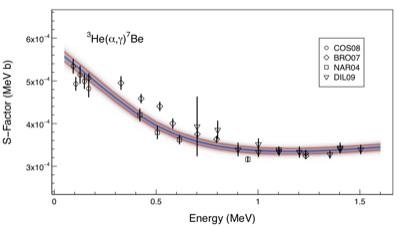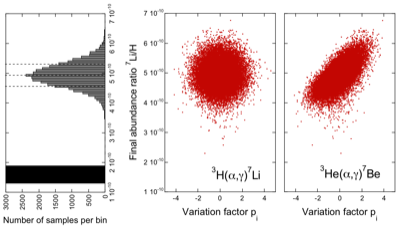
| Cococubed.com |

|
Home
Astronomy research
Software Infrastructure:
MESA
FLASH-X
STARLIB
MESA-Web
starkiller-astro
My instruments
Neutrino Emission:
Neutrinos from de-excitation
Neutrino emission from stars
Identifying the Pre-SN
Neutrino HR diagram
Pre-SN Beta Processes
Pre-SN neutrinos
White dwarf pulsations:
12C(α,γ) & overshooting
Probe of 12C(α,γ)16O
Impact of 22Ne
Impact of ν cooling
Variable white dwarfs
MC reaction rates
Micronovae
Novae
White dwarf supernova:
Stable nickel production
Remnant metallicities
Colliding white dwarfs
Merging white dwarfs
Ignition conditions
Metallicity effects
Central density effects
Detonation density
Tracer particle burning
Subsonic burning fronts
Supersonic fronts
W7 profiles
Massive stars:
Pop III with HST/JWST
Rotating progenitors
3D evolution to collapse
MC reaction rates
Pre-SN variations
Massive star supernova:
Yields of radionuclides
26Al & 60Fe
44Ti, 60Co & 56Ni
SN 1987A light curve
Constraints on Ni/Fe
An r-process
Effects of 12C +12C
Neutron Stars and Black Holes:
Black Hole spectrum
Mass Gap with LVK
Compact object IMF
He burn neutron stars
Stars:
Hypatia catalog
SAGB stars
Nugrid Yields I
He shell convection
BBFH at 40 years
γ-rays within 100 Mpc
Iron Pseudocarbynes
Pre-Solar Grains:
C-rich presolar grains
SiC Type U/C grains
Grains from massive stars
Placing the Sun
SiC Presolar grains
Chemical Evolution:
Radionuclides in 2020s
Zone models H to Zn
Mixing ejecta
Thermodynamics, Opacities & Networks
Radiative Opacity
Skye EOS
Helm EOS
Five EOSs
Equations of State
12C(α,γ)16O Rate
Proton-rich NSE
Reaction networks
Bayesian reaction rates
Verification Problems:
Validating an astro code
Su-Olson
Cog8
Mader
RMTV
Sedov
Noh
Software Instruments
2026 AAS Journals
AAS YouTube
Listing of 500+ Author Videos
AAS Peer Review Workshops
Outreach Material
Education Material
Other Stuff:
Bicycle Adventures
Illustrations
Presentations
Contact: F.X.Timmes
my one page vitae,
full vitae,
research statement, and
teaching statement.
The Impact of Nuclear Reaction Rate Uncertainties On The Evolution of Core-Collapse Supernova Progenitors (2018)
We investigate properties of massive stars with respect to the composite uncertainties in the reaction rates using MESA and STARLIB. This is the first Monte Carlo massive star evolution study that use complete stellar models.
Properties Of Carbon-Oxygen White Dwarfs From Monte Carlo Stellar Models (2016)
We investigate properties of carbon-oxygen white dwarfs with respect to the composite uncertainties in the reaction rates using MESA and STARLIB. This is the first Monte Carlo stellar evolution study that use complete stellar models.
Bayesian Estimation Of Thermonuclear Reaction Rates (2016)
Estimating non-resonant astrophysical S-factors and thermonuclear reaction rates, based on measured nuclear cross sections, is of major interest for nuclear energy generation, neutrino physics, and element synthesis. Many different methods have been applied in the past to this problem, almost all of them based on traditional statistics. Bayesian methods, on the other hand, are now in widespread use in the physical sciences. In astronomy, for example, Bayesian statistics is applied to the observation of extra-solar planets, gravitational waves, and type Ia supernovae. However, nuclear physics, in particular, has been slow to adopt Bayesian methods. In this article we present astrophysical S-factors and reaction rates based on Bayesian statistics. We develop a framework that incorporates robust parameter estimation, systematic effects, and non-Gaussian uncertainties in a consistent manner. The method is applied to the d(p,γ)3He, 3He(3He,2p)4He, and 3He(α,γ)7Be reactions, important for deuterium burning, solar neutrinos, and big bang nucleosynthesis.

|
 |

|
|
Statistical Methods for Thermonuclear Reaction Rates and Nucleosynthesis Simulations (2015)
Rigorous statistical methods for estimating thermonuclear reaction rates and nucleosynthesis are becoming increasingly established in nuclear astrophysics. The main challenge being faced is that experimental reaction rates are highly complex quantities derived from a multitude of different measured nuclear parameters (e.g., astrophysical S-factors, resonance energies and strengths, particle and γ-ray partial widths). In this article we discuss the application of the Monte Carlo method to two distinct, but related, questions. First, given a set of measured nuclear parameters, how can one best estimate the resulting thermonuclear reaction rates and associated uncertainties? Second, given a set of appropriate reaction rates, how can one best estimate the abundances from nucleosynthesis (i.e., reaction network) calculations?
The techniques described here provide probability density functions that can be used to derive statistically meaningful reaction rates and final abundances for any desired coverage probability. Examples are given for applications to s-process neutron sources, core-collapse supernovae, classical novae, and big bang nucleosynthesis.

|
 |

|
 |
STARLIB: A Next-Generation Reaction-Rate Library for Nuclear Astrophysics (2013)
STARLIB, discussed in this article, is a next-generation, all-purpose nuclear reaction-rate library. For the first time, a library provides the rate probability density at all temperature grid points for convenient implementation in models of stellar phenomena. The recommended rate and its associated uncertainties are also included.
Currently, uncertainties are absent from all other rate libraries, and, although estimates have been attempted in previous evaluations and compilations, these are generally not based on rigorous statistical definitions. A common standard for deriving uncertainties is clearly warranted. STARLIB represents a first step in addressing this deficiency by providing a tabular, up-to-date database that supplies not only the rate and its uncertainty but also its distribution. Because a majority of rates are lognormally distributed, this allows the construction of rate probability densities from the columns of STARLIB. This structure is based on a recently suggested Monte Carlo method to calculate reaction rates, where uncertainties are rigorously defined.
In STARLIB, experimental rates are supplemented with: (i) theoretical TALYS rates for reactions for which no experimental input is available, and (ii) laboratory and theoretical weak rates. STARLIB includes all types of reactions of astrophysical interest to Z=83, such as (p,γ), (p,α), (α,n), and corresponding reverse rates. Strong rates account for thermal target excitations. Here, we summarize our Monte Carlo formalism, introduce the library, compare methods of correcting rates for stellar environments, and discuss how to implement our library in Monte Carlo nucleosynthesis studies.
 |

|
 |

|

|
 |

|

|

|

|

|

|